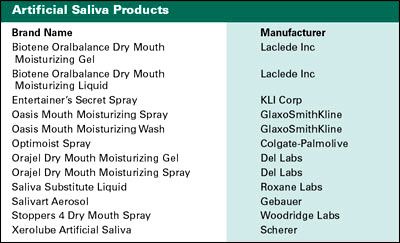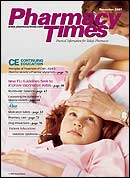Xerostomia Products
Pharmacists play a key role in identifying those most susceptible to dry mouth and helping patients manage it.
Ms. Terrie is a clinical pharmacy writer based in Haymarket,Va.
Pharmacists are likely to receive inquiries about the management of xerostomia—commonly referred to as dry mouth—which affects an estimated 25% of adults.1 Xerostomia is characterized by a reduction or complete deficiency of salivary flow and is a common complaint, especially among the elderly.2-4 An estimated 40% of individuals >55 years of age have some degree of xerostomia.1
Saliva has many important functions, including lubrication of the oral cavity, remineralization, and protection against tooth decay. Saliva also has antimicrobial and buffering properties and aids in swallowing, digestion, control of pH, and overall maintenance of the oral mucosa.1,4 If left untreated, xerostomia can contribute to dental caries, periodontal disease, and other oral health problems such as infections.1
Causes of Xerostomia
There are a variety of factors that may contribute to xerostomia. The most prevalent disease that causes xerostomia is Sj?gren's syndrome, a chronic inflammatory autoimmune disorder in which immune cells attack and destroy the glands that produce tears and saliva.4,5 Sj?gren's syndrome affects 1 million to 4 million individuals in the United States and occurs mostly in postmenopausal women.2,4 It is estimated that women are 9 times more likely to be diagnosed with this syndrome than men.5
A host of other conditions also may contribute to the development of xerostomia, including diabetes mellitus, Crohn's disease, depression, sarcoidosis, scleroderma, hypertension, HIV, chronic active hepatitis, and Parkinson's disease. Individuals receiving radiation therapy to the head and neck may also develop xerostomia.1-4
Table 1

An estimated 64% of all episodes of xerostomia are related to the use of certain medications, and more than 400 drugs or 42 classes of drugs can negatively alter or affect salivary production (Table 1).1,2,4 Pharmacists are key in identifying those individuals most susceptible to dry mouth, assisting patients in the management of xerostomia, and, through these interventions, possibly minimizing its severity.
In some cases, if xerostomia is due to use of a medication, it may be possible to discontinue or change the medication, and the incidence of dry mouth may be reversed. Since the older patient population is more likely to take multiple medications, the probability of developing dry mouth is increased. Examples of nonpharmacologic causes of xerostomia include history of smoking, alcohol use, caffeine, and breathing through the mouth.2
Signs and Symptoms of Xerostomia
Xerostomia, which can differ in degree of severity from one individual to another, may present itself with one or more of the following symptoms1-3:
- Difficulty swallowing dry foods
- Difficulty talking
- Burning tongue
- Stomatitis
- Halitosis
- Difficulty wearing dentures
- Increased need to drink fluids when swallowing
- Sleep interruptions due to thirst
- Increased dental caries
OTC Products for Xerostomia
Artificial saliva products are available for treating the discomfort associated with dry mouth (Table 2). Although these products are formulated to mimic the chemical and physical properties of natural saliva, they do not contain the protective measures of natural saliva.3,4 The artificial saliva products typically contain carboxymethylcellulose and glycerin for viscosity, as well as calcium and phosphate ions.3 Some contain fluoride, and, sometimes, for palatability, a flavoring agent and/or a sweetener (ie, xylitol, sorbitol) is added.3,4 Patients should always be reminded that these products are classified as replacement products and not cures for xerostomia.3
Table 2

Conclusion
Pharmacists can be instrumental in assisting those patients who experience dry mouth by obtaining medical information, including disease states, medication history, and lifestyle practices that may contribute to the condition. In addition, pharmacists should question patients about their symptoms and determine if self-treatment is appropriate. Patients should be encouraged to report the incidence of dry mouth to their primary health care provider for further evaluation and treatment—especially if symptoms persist and worsen—in order to avoid further complications.
As well as recommending products (see also Table 3) available for dry mouth, patients should be reminded of the importance of adherence, and pharmacists can also make recommendations about nonpharmacologic measures available to alleviate the condition. These include chewing gum with xylitol or using sugar-free hard candy to increase the flow of saliva and avoiding caffeinated beverages, alcohol, and smoking. Patients should also be encouraged to practice good oral hygiene and to visit their dentist routinely.
Table 3

References
- Facts About Dry Mouth. GlaxoSmithKline Consumer Information Web site. Available at: www.dental-professional.com/pdfs/oasis/drymouth.pdf.
- Causes of Xerostomia. Oasis Professional Information Web site. Available at: www.oasisprofessional.com/Xerostomia_Causes.aspx.
- Klasser G, Greene C. Oral Pain and Discomfort. In: Berardi RR, Kroon LA, McDermott JA, et al, eds. Handbook of Nonprescription Drugs. 15th ed. Washington, DC: American Pharmacists Association; 2006:701-708.
- Bartels C. Helping People with Dry Mouth. Oral Cancer Foundation Web site. Available at: www.oralcancerfoundation.org/dental/xerostomia.htm.

